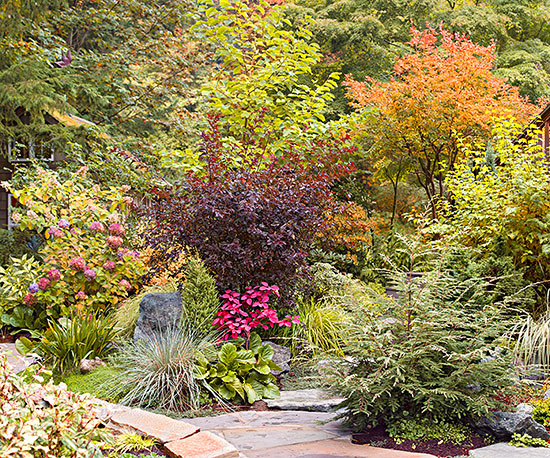






When it comes to gardening, spring and summer often take the spotlight. Everything seems fresh and new, bright and beautiful, ready for warming rays and nurturing rains. When autumn rolls around, gardening can get a bit more complicated. There's less sunshine, often-fickle temperatures, and the waning luster of plants on a slowdown. But a well-designed fall landscape can be just as beautiful as one in the height of summer. Here are seven ideas to help you with planning a fall garden.
continue reading belowPlanning a fall garden means figuring out what you want that garden to do. Would you like your landscape to continue a color and texture show you started in spring and summer? Does your changing landscape need to hide the unsightly facade of your home or enhance a particularly beautiful spot in your yard? Perhaps you just want a fall garden to highlight some of the colors and plants unique to autumn, while filling in blank spots in flowerbeds as warm-weather plants die back. Spend some time thinking through how your garden design and plants should function in autumn, and what you hope to accomplish with your fall garden.
Try one of our free fall garden plans.
As the year winds down, so too do the hours that you'll spend outside. "Take a look at your garden from the inside. What do you want to see out your windows in fall?" says Leslie Land, author of The New York Times 1,000 Gardening Questions & Answers and blogger at leslieland.com. That view will help guide what you choose and where you place it when planning a fall garden.
Create a fall container garden.
"The rules for good gardening are not repealed in fall," Land says. Let the same elements you use in spring and summer -- complementary shapes and colors, pretty foliage, repetition of flowers for visual consistency -- remain your standbys and must-dos when planning a fall garden.
Although many plants do bloom either late in the summer or in the fall, Land says, nonflowering plants really come into their own later in the year, too; ornamental grasses are a notable example. They are definitely a good fit for a fall garden. "It's good to be reminded how many ways there are to have beautiful colors with plants that don't have flowers," she says.
Check out top ornamental grasses.
Plants often undergo an autumn metamorphosis when foliage turns a different color and branches have more of a presence. Land has several favored plants that really shine in a fall garden. "My favorite fall item, oakleaf hydrangea, does everything; it's a four-season delight," she says. The foliage changes, the flower heads dry, and the plant offers structure through winter. "Any clematis has terrific seed heads and you get fall gorgeousness from that."
Learn more about hydrangeas.
Even without leaves, many trees supply distinctive, sculptural autumn outlines. In addition, many old favorites have been bred as dwarf varieties, making it simpler to include distinctive specimen trees when you're planning a fall garden. "It's really notable that in the last 30 years, there are more manageable size forms of big trees," Land says. "For example, you can find really nifty dwarf Chinese elms that never get more than 15 feet tall." Shrubs, too, offer berries (an added attraction for wildlife) that give them multifaceted appeal in a fall garden.
See top trees and shrubs for fall.
Of course, flowers such as mums and asters are standbys, but unique versions of even these stalwarts will make your garden the belle of the block, Land says. Look for unusual, autumn-hardy varieties to include when planning a fall garden. Land suggests planting a wide band of Korean mums; constantly shear the front 18 inches for a beautiful groundcover in front with flowers in the back.
Check out these great fall bloomers.
Learn more fall lessons from our Test Garden.
Copyright © www.100flowers.win Botanic Garden All Rights Reserved